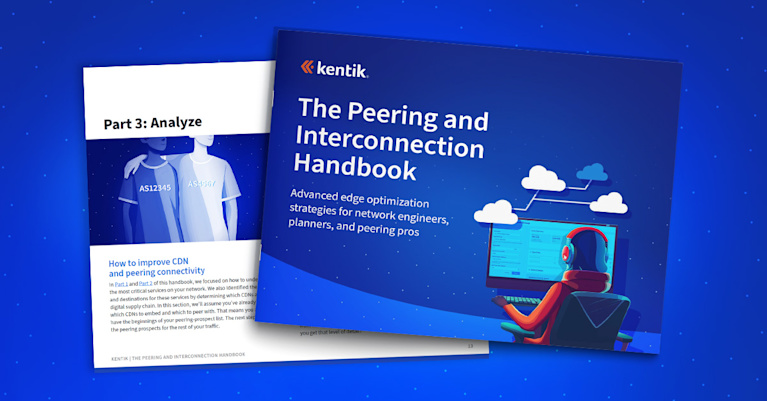What is Internet Peering (BGP Peering)?
Internet peering is a connection between two IP networks that allow traffic to flow from sources in either of the networks to destinations in the other without allowing traffic to flow to destinations traversing the peer—or in other words, to travel via the internet.
Peering is configured using BGP (Border Gateway Protocol) which exchanges routing information between two systems, defined by their Autonomous System Numbers (ASNs). The configuration of BGP on both sides of the connection determines whether the connection is a “peering” or an “internet access/transit” type of connection.
Peering is an essential strategy for businesses that: (1) want to reduce their cost of transit, (2) want to reduce the complexity of their connection to a destination by connecting directly, (3) require higher network performance, (4) seek greater security.
Advanced edge optimization strategies for network engineers, planners, and peering pros

How does network peering work?
Network peering works by allowing devices on one network to exchange traffic directly with devices on another network. Peering provides more direct control over how you participate in the internet.
For example, a business might have an application hosted on-premises to download data from the public cloud. The application could access the data over the internet, the typical approach.
However, if the business sets up a peering connection between the on-premises location and the public cloud, data is downloaded directly without using the public internet. In other words, the data downloads without using third-party providers that do not provide the level of control needed.
Two types of interconnections: transit vs. peering
Let’s take a little broader view for a moment, just to put internet peering in context. Peering is a type of interconnection, and generally, there are two types of interconnections:
-
Transit: The networks interconnect so that one (usually an ISP, telco, or carrier) can provide reachability to the entire Internet for the other, which is typically an “endpoint” entity (e.g., enterprise, content or application provider, residential broadband provider, etc.). In most cases, there is a commercial relationship. The endpoint entity pays the ISP to carry traffic to and from the Internet.
-
Peering: The networks interconnect to exchange only traffic that originates or terminates within their networks (including the networks of their customers, in the case of carriers and Tier 1 networks).
Historically, peering was established between networks that found a mutual benefit from the connection without payments between the parties.
Two types of peering connections: public vs. private peering
In addition to the two types of interconnections, there are also two types of peering connections as you get deeper into how multiple networks connect. These two types are public peering and private peering.
Public peering
Public peering is done through an internet exchange point (IXP). This is where one network can peer with multiple networks through a single connection to the IXP to the IXP. The IXP can be a single ethernet switch or a multi-location ethernet network where the participants can connect and reach the other participants via the exchange. The BGP connections used for public peering can be to a route server, bilateral sessions to individual ASNs, or a combination.
Private peering
Private peering is when two networks agree to exchange their traffic directly via a dedicated IP connection. Private peering is often preferred when a massive amount of network traffic needs to be exchanged. The dedicated IP connection is typically created via a direct fiber between the two networks in a colocation facility where both have a presence, but can also be realized using dark fiber or transport between networks that do not have a common location, or via a virtual connection through a third-party network.
How to set up peering
For an IP network to peer, it needs an ASN (Autonomous System Number) and its own public IP address space. Peering is then configured using BGP (Border Gateway Protocol) which exchanges routing information between the two ASNs. BGP is also used for internet access when businesses have an ASN and their own address space. The configuration of BGP on both sides of the connection determines whether it is a peering or internet access/transit connection.
Typically a peering coordinator will then be responsible for managing the way an IP network connects to the rest of the internet. Learn more about essential methods, tips and tricks for connecting your IP network to the rest of the internet in Kentik’s ebook, The Peering Coordinators’ Handbook: Foundations of the Peering Trade.
BGP is used for the logical connection but needs a physical or virtual path between the two networks that connect. The most common approaches for this are:
- Establish a point of presence for the business’ network in a data center with the presence of IXPs, public clouds, and other networks and connect.
- Use a metro fiber or similar to connect to the IXP, the public cloud, or the network to whom you want to connect.
- Configure a virtual path on your internet access connection to the IXP, public, or the network to whom you want to connect.

Identifying and negotiating a peering agreement
The first task of network peering is to identify potential peering targets that will mutually benefit from a direct interconnection. For example, if a certain internet service provider (ISP) determines that a large volume of network traffic comes and goes from another ISP, they can decide to peer with each other to save costs or improve network performance. This type of network traffic analytics is typically done using NetFlow.
Once a potential peering partner is identified, the next step is to understand their peering policy and evaluate the potential for connection.
The basics of peering policies
A peering policy is a declaration of a network’s intentions to peer. A network can state if it has the following:
- Open peering policy - the network will peer with everyone and everywhere possible
- Selective peering policy - the network will generally peer, but there are a set of requirements that define how mutual benefit can be gained from peering
- Restrictive peering policy - the network will peer, but is not seeking new peers and will generally decline any requests
The peering prospects with an open peering policy are straightforward—it’s just a question of reaching out and agreeing on where and when. The same is often true for those peering prospects with a selective peering policy, but often one needs to prove that the policy requirements are met.
Once there is agreement, cross-connects must be run in the case of private peering and BGP sessions must be configured and brought into operation so that network traffic will flow.
The benefits of peering
By making it possible to avoid routing traffic over the internet, peering provides several significant advantages:
- Security: While peering doesn’t prevent all types of network-borne threats, it can reduce the risk of data sniffing and internet-based exploits.
- Performance: Since peering is a direct connection, latency and capacity are controlled by only the two parties in the relationship. For this reason, performance is often better than when routing via the internet and the internet service provider’s customers will have a better user experience.
- Reliability: Similarly, peer networks may be more reliable because they won’t be disrupted by issues such as a DDoS attack against an ISP’s infrastructure.
- Lower costs: Peering provides a direct path to exchange traffic instead of sending that traffic through transit proviers. And although peering can require significant investment to implement, one can reduce ongoing operating expenses, especially when businesses have to pay high transit costs to send data over the public internet.
- Control: Connecting directly to the networks that provide critical service for you or your customers increases your control over quality-of-service. In cases where continuous, reliable network traffic is critical (e.g., video streaming), having control over performance is an essential service.
When to use peering
While peering provides many advantages, it’s not trivial to set up or manage. So, how do you decide if peering is the right choice for you and develop an understanding of potential peers and with whom to partner?
The simple and obvious answer is a financial one: it’s usually beneficial for companies to engage in network peering when it is cheaper to do so.
About Kentik’s peering solution
Kentik can help you find peering targets and understand the impact on connectivity. You can optimize cost and improve performance by peering more efficiently. Kentik enables you to evaluate potential peering partners, measure traffic ratios, and build data-driven business cases to support interconnection decisions.
Start a free trial to try it yourself.
Related internet peering and BGP peering topics
-
Learn more about using Kentik for peering and interconnection use cases
-
The peering coordinators’ toolbox - part 1 in a series on network peering
-
Customer Spotlight: How EdgeUno Delivers Leading Internet Services in LATAM
-
How Zoom Uses Kentik for Network Observability, Including Internet Peering Analytics
-
Network AF Podcast: Backbone engineering and interconnection with Nina Bargisen

